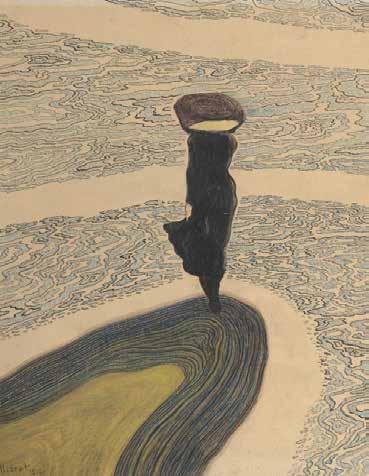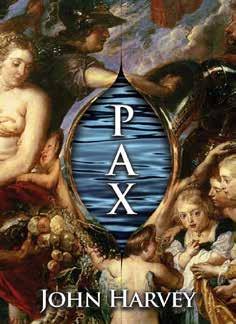
7 minute read
The Twilit World of Léon Spilliaert at the Royal Academy
from Oremus March 2020
NEW AT THE ROYAL ACADEMY The Twilight World of Early 20thcentury Belgium
Last month, the Royal Academy of Arts opened the first major exhibition of Belgian artist Léon Spilliaert (1881–1946) to be held in the UK. Bringing together around 80 works drawn from public and private collections across Belgium, France, Great Britain and the USA, the exhibition offers a rare opportunity to discover this intriguing, singular artist who left an indelible mark on the 20th century art of Belgium.
Born in Ostend, the seaside resort on the North Sea coast patronised by the Belgian royal family, Spilliaert was a selftaught artist. Eschewing oil paint, he worked in combinations of Indian ink wash, Conté crayon, watercolour, gouache, pastel, chalk, pencil and pen on paper or cardboard, to create atmospheric works that are often imbued with mystery and melancholy. As a young man, plagued by insomnia and a chronic stomach condition, Spilliaert regularly walked along the deserted promenade and through the streets of Ostend in the dead of night, afterwards capturing the emptiness of the beach and town in a sequence of dynamic views defined by unusual perspectives and reflected light. Fuelled by existential angst, he also created a series of visionary self-portraits that reveal his preoccupation with his identity as an artist. These potent images of solitude align him with Nordic artists such as Edvard Munch, Vilhelm Hammershøi and Helene Schjerfbeck, who likewise wrestled with visual explorations of the self at the turn of the 20th century.
A love of literature and philosophy, in particular the work of Edgar Allan Poe and Friedrich Nietzsche, shaped much of Spilliaert’s early work, which has a brooding and at times romantic intensity to it. In 1902, he started working for the Brussels publisher Edmond Deman, illustrating works by the playwright, poet and essayist Maurice Maeterlinck (who, in 1911, became the only ever Belgian recipient of the Nobel Prize for Literature) and the poet Emile Verhaeren, with whom he formed a close friendship. The latter would be responsible for introducing the artist to numerous art and literary figures, including the Austrian novelist Stefan Zweig and the Belgian playwright Fernand Crommelynck.
Fleeing Ostend in 1917 to escape the German occupation, Spilliaert and his new wife Rachel Vergison set off for Geneva, where they planned to join a pacifist movement. But with little money and a new baby, they got no further than Brussels. Spilliaert would move between Ostend and Brussels for the rest of his life. Always fascinated by the natural world, his later work developed a softer focus, and he produced contemplative, tranquil works that conjure evening light or the shadows of beech trees in the Forêt de Soignes in Brussels, where he walked regularly.
20 Leon Spilliaert, Woman at the Shoreline, 1910. Indian ink, coloured pencil and pastel on paper, 49 x 60 cm. Private collection. © Cedric Verhelst
The exhibition is organised in four thematic sections, presenting a journey through the lifetime of this remarkably insightful and unusual artist. Entitled Illumination, section one will focus on Spilliaert’s engagement with literature, theatre and book illustration and introduce his poetic visions of nature, including Beech Trunks, 1945 (Private Collection). Section two, Crépuscule, will explore Spilliaert’s expressions of emptiness and loneliness in the twilit world he inhabited. Still-lifes and interior scenes transmit a quiet glow in the depths of night, and, as in Young Woman on a Stool, 1909 (the Hearn Family Trust) solitary women wait for their husbands to return from sea at the end of the day. This section will also include examples of a commission to illustrate Belgique II, one of the first airships in Belgium. Section three, Littoral, examines Spilliaert’s fascination with the liminal areas between land and sea, and, as seen in A Gust of Wind, 1904 (Mu.ZEE) and Dike at night. Reflected lights, 1908 (Musée d‘Orsay), his depictions of the streets, beach and promenade of Ostend. The final section, Reflections, brings together an important group of self-portraits. The Exhibition runs until Monday 25 May, 10am – 6pm daily (last admission 5.30pm) and Fridays until 10pm (last admission 9.30pm). Full price £14 (£12 excluding Gift Aid donation); concessions available; under 16s go free (T&Cs apply); Friends of the RA go free. Tickets are available daily at the RA or visit royalacademy. org.uk.
The Year in Prospect

Christina White

The Professor’s book
It was John Clare who memorably described March as the month of many weathers, but I hope that this year winter will be ‘half weary of his toil’. In anticipation of warmer and longer days there is a distinctive theme to the Friends’ events this season with visits to beautiful gardens planned and some fine and eloquent speakers to raise the spirits.
Dr Rory O’Donnell accompanied us on the trip to Ingatestone last year and he is generously giving of his time and expertise again with a planned outing in May in the footsteps of the Catholic architect John Walters, visiting St John’s Seminary in Wonersh, where the Rector has kindly offered lunch. and the Benedictine community at Chilworth, where we will stay for Vespers and tea. Eagle-eyed Friends may spot that Wonersh was used for filming in Foyle’s War! Professor John Harvey comes to the Cathedral on 22 April to talk on Peter Paul Rubens, who was a devout Catholic and important ambassador of his day, helping to broker peace in Europe. John will be talking about Rubens in the light of his recent novel Pax. Later in the year we will visit the Wallace Collection to see two Rubens paintings re-united for the first time in over 200 years. Please come to Professor Harvey’s talk; he is a brilliant speaker.
We promised a blessing of the plaque in the Chapel of St George and the English Martyrs and this will happen on St George’s Day. Canon Christopher will lead the prayers with a special mention for all the donors and the people dedicated in the memorial plaque. There will be a small reception to follow for major donors to the appeal. All are welcome to attend the blessing. Donors will receive their invitation by post. We are nearly at capacity for the Friends’ Clerkenwell walk on 6 March, but please do phone the office if you wish to come; we may have some late availability.
Looking forward, we have our Summer Party at St Mary Moorfields on 2 July and a very special visit to the Old Bailey in June for a private tour and drinks reception. 2020 marks the 850th anniversary of the death of St Thomas Becket and at the time of writing we have a speaker booked to talk about Becket and his impact on London, in life and in death. Alison Weir returns to speak on Kathryn Howard: The Scandalous Queen. Details of all these events are listed in the Friends’ Newsletter.
If you or a friend would like to join the Friends in 2020 and support the Cathedral please call 0207 798 9059. The Friends receive prior notice of all events and are given priority for booking. The Cathedral more than ever needs its Friends. Thank you for your interest and support.
Forthcoming Events Friday 6 March: A Walk Through Historic Clerkenwell with Anthony Weaver: including Mass at St Etheldreda’s, pub lunch and visits to the museums of the Charterhouse and the Hospital of St John. Meet at St Peter’s Italian church at 10am. Please note this is a full-day walking tour. Tickets £30 Wednesday 25 March: Quiz and Curry. Cathedral Hall 6.30pm. Please indicate whether you want Chicken Madras, Lamb Korma or Vegetable Biryani. Tickets £18 Wednesday 22 April: Professor John Harvey – Rubens in London. To mark the publication of John’s book Pax, a talk on Rubens – Catholic, diplomat and artist, focusing on his time in London. Cathedral Hall. Doors open at 6.30 for 7pm Tickets £10. Thursday 23 April: Prayers and a reception for major donors to mark the formal installation of the donors’ plaque in St George’s Chapel. All are welcome to attend the prayers; the donors’ reception is by invitation only. Blessing in the Chapel after the 5.30pm Mass. Thursday 7 May: In the footsteps of the Catholic architect John Walters with Dr Rory O’Donnell. Our day will include a visit to the seminary at Wonersh where we will have Mass and lunch in the refectory. After lunch we will travel to Albury Park to see the church of Ss Peter and Paul with its Pugin reredos and then on to the Benedictine Monastery at Chilworth where we will stay for Vespers. Lunch and afternoon tea included. Coach will depart from outside Clergy House at 9am. Tickets £45 Tuesday 19 May: Tonbridge, Tudeley and Penshurst Place. A fascinating day taking in All Saints’ church, Tudeley with its unique Chagall windows and the historic Penshurst Place. We will have Mass at Tonbridge. A ploughman’s lunch is included and we have been invited to a garden tea – weather permitting – with some close Friends. Pricing and further details in the next issue of Oremus.
Contact us
• Write to: Friends’ Office, 42 Francis Street, London SW1P 1QW • Call: 020 7798 9059 • Email: friends@ westminstercathedral.org.uk Registered Charity number 272899










